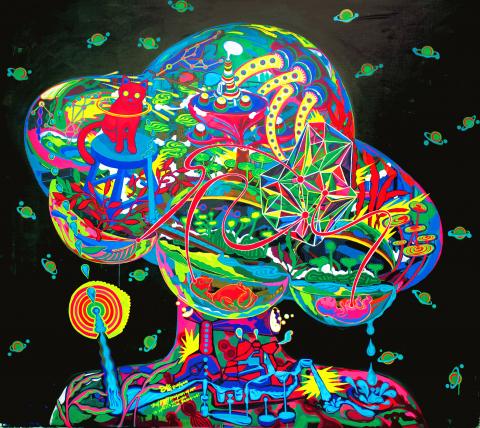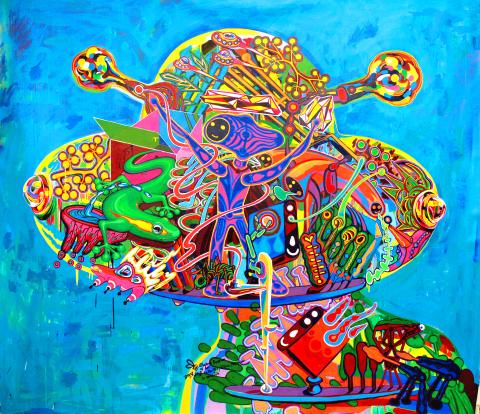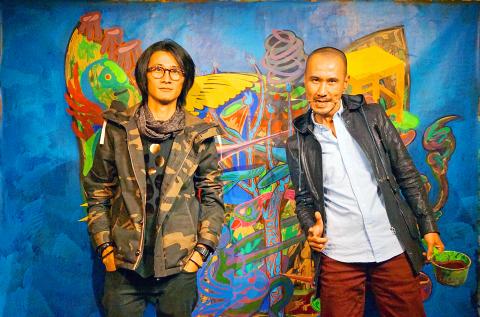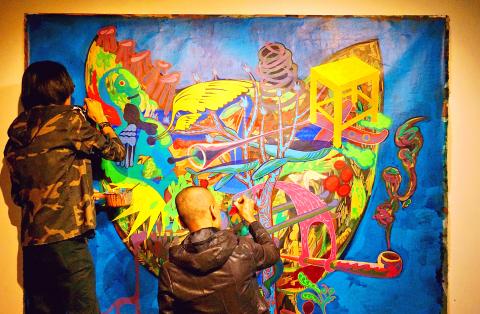Lu Mu-jen (呂沐芢) and Chiao Sheng-wei (焦聖偉) are childhood best friends and artists who are out of this world. Their collection of artwork depicting various alien, plant and animal life forms intertwined inside UFO-shaped single-celled organisms is currently on display at Frees Art Space (福利社) in Taipei’s Zhongshan District (中山).
When asked if they believe in aliens, both artists responded in the positive with blank looks on their faces which read, why is this question even being asked? Lu has never seen an alien in real life, but Chiao says he’s seen something that looked like a UFO when he was at graduate school in Greater Tainan. Despite their different experiences though, both artists steadfastly believe that life on other planets exist and use this as inspiration for their newest collection, the Euglena Program of Art.
COMMUNICATION IS KEY

Photo Courtesy of Association of the Visual Arts in Taiwan
The artists were putting the finishing touches on their latest addition to the collection, dabbing paint on their canvas in near-perfect sync as photographers snapped away and reporters scribbled in their notepads. Lu and Chiao never discuss what to paint beforehand. Their style is impromptu and organic — they simply pick up their brushes and see where the painting takes them.
“It’s like we are having a conversation with each other but with brush strokes, not words, and it’s exciting not knowing what the next brush stroke or what the end result will be” Lu said.
Communication is one of the key messages in their artwork. Within the earth itself there are numerous modes of communication, many of which are not discernible to the human eye or ear.

Photo Courtesy of Association of the Visual Arts in Taiwan
“Take dolphins for instance,” Lu said, referring to the dolphins in many of their paintings. “They are highly intelligent creatures who communicate through their sonar abilities.”
Lu and Chiao’s logic is that just because humans cannot see, hear, touch, taste or feel something does not mean that it does not exist. Naturally, this logic extends to aliens and life on other planets — perhaps other-worldly creatures use other means of communication, and they have been trying to reach out to us, but we simply cannot detect their message.
The Euglena Program of Art is essentially Lu and Chiao projecting this logic onto canvas. As Chiao says, “no one can yet prove the existence of aliens, so we feel like we have to express it through art instead.”

Photo: Dana Ter, Taipei Times
OTHER-WORLDLY BUT DOWN-TO-EARTH
From afar, the Euglena Project of Art resembles colorful UFO heads. Up close, it’s more of a mish-mash of animals, organisms and elements thrown together — dolphins that swim upstream, cats that smoke cigars and aliens that sprout eagle-like wings. And yet — maybe it’s the random smiley faces interspersed throughout almost every painting — it just seems like everything is coexisting in perfect harmony, or at least, the different elements are trying to understand each other.
“We draw such animals and aliens altogether because they are all very smart creatures,” Lu said.

Photo: Dana Ter, Taipei Times
He adds that he and Chiao both grew up loving the abundance of nature in Taiwan and watching all sorts of television shows and movies. As a result, their art has been influenced by four main tenets: aliens, nature, environmental issues and human beings like Bruce Lee (李小龍) or Michael Jackson who have changed the world in a positive way.
“Such a combination is not possible in real life, but in art, it’s possible,” Chiao says, “therefore, our paintings represent a type of hope.”
Just as there is no definitive answer to the question “do aliens exist?”, there is no definitive meaning behind Lu and Chiao’s paintings. Lu says that the paintings show how “aliens are trying to teach us peaceful messages like mutual understanding and how to preserve the environment.”
Chiao says that to him, the most important message is “a feeling of harmony.”
Likewise, each individual will have his or her own interpretation, although Lu and Chiao say that they hope their artwork will evoke happy feelings in their viewers since they were largely inspired by elements and experiences which made them happy.
So, while Lu and Chiao may seem out of this world, their desire for peaceful coexistence amongst the various elements of worldly and other-worldly life forms is rather endearing and down-to-earth.

The Taipei Times last week reported that the rising share of seniors in the population is reshaping the nation’s housing markets. According to data from the Ministry of the Interior, about 850,000 residences were occupied by elderly people in the first quarter, including 655,000 that housed only one resident. H&B Realty chief researcher Jessica Hsu (徐佳馨), quoted in the article, said that there is rising demand for elderly-friendly housing, including units with elevators, barrier-free layouts and proximity to healthcare services. Hsu and others cited in the article highlighted the changing family residential dynamics, as children no longer live with parents,

It is jarring how differently Taiwan’s politics is portrayed in the international press compared to the local Chinese-language press. Viewed from abroad, Taiwan is seen as a geopolitical hotspot, or “The Most Dangerous Place on Earth,” as the Economist once blazoned across their cover. Meanwhile, tasked with facing down those existential threats, Taiwan’s leaders are dying their hair pink. These include former president Tsai Ing-wen (蔡英文), Vice President Hsiao Bi-khim (蕭美琴) and Kaohsiung Mayor Chen Chi-mai (陳其邁), among others. They are demonstrating what big fans they are of South Korean K-pop sensations Blackpink ahead of their concerts this weekend in Kaohsiung.

Taiwan is one of the world’s greatest per-capita consumers of seafood. Whereas the average human is thought to eat around 20kg of seafood per year, each Taiwanese gets through 27kg to 35kg of ocean delicacies annually, depending on which source you find most credible. Given the ubiquity of dishes like oyster omelet (蚵仔煎) and milkfish soup (虱目魚湯), the higher estimate may well be correct. By global standards, let alone local consumption patterns, I’m not much of a seafood fan. It’s not just a matter of taste, although that’s part of it. What I’ve read about the environmental impact of the

Oct 20 to Oct 26 After a day of fighting, the Japanese Army’s Second Division was resting when a curious delegation of two Scotsmen and 19 Taiwanese approached their camp. It was Oct. 20, 1895, and the troops had reached Taiye Village (太爺庄) in today’s Hunei District (湖內), Kaohsiung, just 10km away from their final target of Tainan. Led by Presbyterian missionaries Thomas Barclay and Duncan Ferguson, the group informed the Japanese that resistance leader Liu Yung-fu (劉永福) had fled to China the previous night, leaving his Black Flag Army fighters behind and the city in chaos. On behalf of the